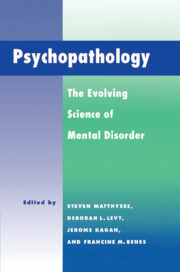Book contents
- Frontmatter
- Contents
- List of Contributors
- Preface
- Brain mechanisms
- Development
- Thinking
- Genetics
- 20 Editors' introduction: Contemporary issues in the genetics of psychopathological disorders
- 21 Genetic and environmental factors in the etiology of schizophrenia
- 22 Problems and paradoxes in research on the etiology of schizophrenia
- Comments on Einar Kringlen's chapter
- 23 Epistemological issues in psychiatric research
- 24 Searching for major genes for schizophrenia
- 25 The Drosophila eye and the genetics of schizophrenia
- Response and reflections
- Author index
- Subject index
20 - Editors' introduction: Contemporary issues in the genetics of psychopathological disorders
Published online by Cambridge University Press: 04 May 2010
- Frontmatter
- Contents
- List of Contributors
- Preface
- Brain mechanisms
- Development
- Thinking
- Genetics
- 20 Editors' introduction: Contemporary issues in the genetics of psychopathological disorders
- 21 Genetic and environmental factors in the etiology of schizophrenia
- 22 Problems and paradoxes in research on the etiology of schizophrenia
- Comments on Einar Kringlen's chapter
- 23 Epistemological issues in psychiatric research
- 24 Searching for major genes for schizophrenia
- 25 The Drosophila eye and the genetics of schizophrenia
- Response and reflections
- Author index
- Subject index
Summary
For many years empirical research supported the genetic independence of schizophrenia and the affective disorders. Morbid risk for schizophrenia was found to be significantly elevated among relatives of schizophrenics, but not among relatives of affective disorder patients. Moreover, morbid risk for affective disorders was found to be heightened among relatives of patients with affective disorders, but not among relatives of schizophrenics. Twin studies also yielded concordance rates in monozygotic (MZ) and dizygotic (DZ) twins that were consistent with a genetic etiology for each disorder, but not with a genetic relation between the two disorders.
More recent work indicates that both the magnitude of the risk and the specificity of familial liability for schizophrenia were probably overestimated in early studies. These changes are largely a function of refinements in methodology that include: (1) blind diagnostic evaluations of family members, (2) diagnostic data that are now almost routinely based on personal interviews, (3) inclusion of psychiatric and normal control groups, (4) use of standardized diagnostic interviews, (5) use of population-based as well as hospitalized samples, and (6) the availability of operationalized diagnostic criteria, which tend to restrict rather than broaden the boundaries of a disorder. For similar reasons concordance rates in early twin studies may have been inflated (Gottesman and Shields, 1972).
- Type
- Chapter
- Information
- PsychopathologyThe Evolving Science of Mental Disorder, pp. 455 - 476Publisher: Cambridge University PressPrint publication year: 1996



